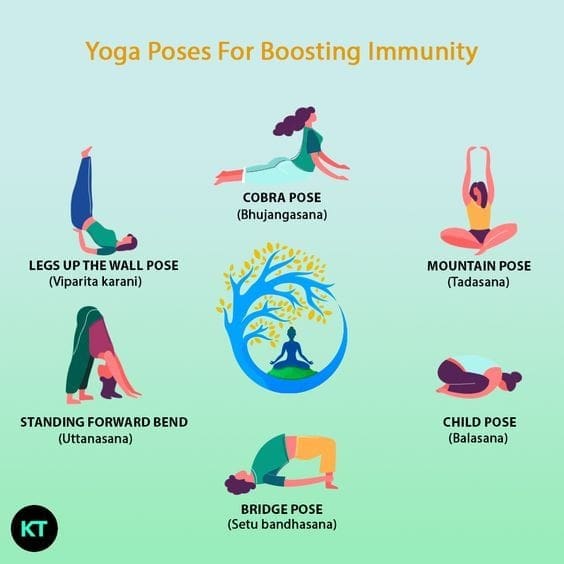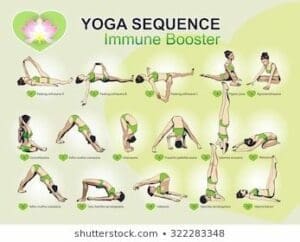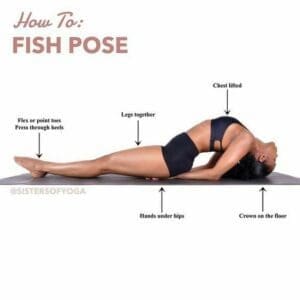In an era where a robust immune system is more important than ever, yoga emerges as a preferred method for fortifying overall health and Immune Boosting. This article delves into the world of Immune Boosting yoga, spotlighting five pivotal poses that can significantly uplift your well-being and Immune Boosting. These practices do more than just bolster Immune Boosting; they offer stress relief, enhance circulation, and provide holistic benefits to both mind and body. So, unfurl your yoga mat, embrace a moment of deep, mindful breathing, and embark on a journey to superior health and Immune Boosting with these transformative yoga poses.
Warrior II (Virabhadrasana II)
Warrior II, also known as Virabhadrasana II, is a powerful yoga pose that not only strengthens our muscles but also boosts our immune system. This pose is especially beneficial for enhancing our lung capacity and stimulating the respiratory system, which is crucial for maintaining a strong immune system.
To practice Warrior II, start by standing at the front of your yoga mat. Step your left foot back and turn it out slightly, ensuring your right foot is pointing forward. Extend your arms out to the sides and parallel to the ground, with your palms facing down. Bend your right knee while keeping your left leg straight and strong. Gaze over your right fingertips and hold this pose for several deep breaths.
Warrior II helps to improve circulation and lymphatic flow in our body, which aids in the transportation of immune cells, toxins, and waste products. By practicing this pose, we can enhance the efficiency of our immune system and promote overall health and well-being.
Modification: Extended Warrior II
For an extra challenge in Warrior II, you can try the Extended Warrior II variation. To do this, slide your left hand down your left leg and reach your right arm up and over your head, creating a diagonal line from your left heel to your right fingertips. This modification further engages the core and stretches the side body, allowing for a deeper opening in the chest and shoulders.
Downward Facing Dog (Adho Mukha Svanasana)
Downward Facing Dog, or Adho Mukha Svanasana, is a foundational pose in yoga that not only energizes our body but also improves our immune system. This inversion pose increases blood flow to the head and enhances the efficiency of our lymphatic system, which helps to flush out toxins and strengthen our immune response.
To practice Downward Facing Dog, begin on your hands and knees. Align your wrists directly under your shoulders and your knees under your hips. Spread your fingers wide and tuck your toes under. Lift your knees off the ground and press your hips up and back, creating an inverted “V” shape with your body. Keep your arms straight and your heels reaching toward the ground. Breathe deeply and hold this pose for a few breaths.
By regularly practicing Downward Facing Dog, we can boost our immune system by stimulating the lymphatic system and improving the circulation of lymph fluid throughout our body. This pose also helps to relieve stress and tension, which can have a negative impact on our immune response. So, roll out your mat and give Downward Facing Dog a try!
Modification: Puppy Pose
If Downward Facing Dog feels too intense or if you have tight shoulders or wrists, you can try a modification called Puppy Pose. Start in a tabletop position with your hands shoulder-width apart and your knees hip-width apart. Walk your hands forward, keeping your hips directly above your knees. Lower your forehead to the mat and relax your chest and shoulders. This gentle backbend will still provide many of the immune-boosting benefits of Downward Facing Dog, while being more accessible for those with limited flexibility or mobility.
Bridge Pose (Setu Bandhasana)
Bridge Pose, also known as Setu Bandhasana, is a rejuvenating yoga pose that not only strengthens our back and leg muscles but also stimulates our immune system. This pose helps to improve blood circulation, open the chest, and stimulate the thyroid gland, which plays a crucial role in maintaining a healthy immune system.
To practice Bridge Pose, lie flat on your back with your knees bent and your feet hip-width apart. Place your arms alongside your body, palms facing down. Press your feet into the ground as you lift your hips off the mat, creating a bridge shape with your body. Engage your glutes and thighs, while keeping your neck and shoulders relaxed. Hold this pose for a few breaths, focusing on deep diaphragmatic breaths.
Bridge Pose not only strengthens our muscles but also boosts our immune system by stimulating the thymus gland, which is responsible for producing T-cells. These cells are essential for fighting off foreign invaders and maintaining a strong immune response. So, roll up your yoga mat and incorporate Bridge Pose into your practice for enhanced immunity.
Modification: Supported Bridge Pose
For a gentler variation of Bridge Pose, you can try Supported Bridge Pose. To do this, place a yoga block or bolster under your sacrum before lifting your hips. By elevating the hips, this modification provides additional support and allows for a deeper relaxation in the pose. This version is particularly beneficial for those with lower back pain or discomfort.
Supported Shoulderstand (Salamba Sarvangasana)
Supported Shoulderstand, or Salamba Sarvangasana, is a powerful inversion pose that not only strengthens our upper body but also activates and strengthens our immune system. This pose offers numerous benefits, including improved blood circulation, enhanced lymphatic flow, and increased oxygenation to the brain.
To practice Supported Shoulderstand, lie on your back with your arms alongside your body, palms facing down. Lift your legs up toward the ceiling, engaging your core muscles. Place your hands on your lower back for support as you lift your pelvis off the mat and bring your legs overhead, resting your weight on your shoulders and upper arms. Keep your neck long and relaxed, and breathe deeply in this pose for several breaths.
Supported Shoulderstand promotes healthy thyroid and parathyroid gland function, which helps to regulate our metabolism and enhance our immune system. Additionally, this inversion pose stimulates lymphatic flow, allowing for efficient removal of toxins and waste products from our body. Practice Supported Shoulderstand regularly to improve your immune response and boost overall health.
Modification: Legs-Up-The-Wall Pose
If Supported Shoulderstand is too challenging or inaccessible for you, a modification called Legs-Up-The-Wall Pose can provide similar benefits. Start by sitting sideways against a wall with your buttocks close to the wall. Lie on your back and extend your legs up the wall, relaxing your arms by your sides. This gentle inversion allows for improved blood circulation, lymphatic drainage, and a sense of relaxation and calm. Stay in this pose for several minutes to experience its immune-boosting effects.
Camel Pose (Ustrasana)
Camel Pose, or Ustrasana, is a heart-opening yoga pose that not only strengthens our back muscles and improves posture but also stimulates our immune system. This pose helps to improve blood circulation, opening the chest and facilitating optimal functioning of our thymus gland, which is responsible for the production of T-cells and maintaining our immune response.
To practice Camel Pose, start by kneeling on your mat with your knees hip-width apart. Place your hands on your lower back, fingers pointing downward. Inhale and lengthen your spine, then exhale and gently lean back, extending your tailbone toward your knees. If you feel comfortable, reach your hands back and try to grasp your heels. Allow your head and neck to relax and drop back if it feels natural. Stay in this pose for a few breaths, breathing deeply and focusing on opening your heart center.
Camel Pose not only strengthens our immune system but also brings a sense of openness, courage, and vulnerability. By practicing this pose, we can cultivate emotional well-being and resilience, which are essential for maintaining a healthy immune response. So, let’s stretch out our bodies and hearts with Camel Pose for enhanced health.
Modification: Supported Camel Pose
If reaching your heels in Camel Pose is challenging or if you have tight shoulders or limited flexibility in your spine, a modification called Supported Camel Pose can provide similar benefits. Place a bolster or folded blanket vertically behind you, parallel to your spine. As you lean back, rest your hands on the prop for support and adjust its height according to your comfort level. This modification allows you to experience the opening and rejuvenating effects of Camel Pose while providing additional support and stability.
Fish Pose (Matsyasana)
Fish Pose, or Matsyasana, is a rejuvenating and energizing yoga pose that not only stretches the muscles in our chest and throat but also stimulates our immune system. This pose helps to improve respiratory function, enhance blood circulation, and strengthen our thymus gland, which plays a vital role in supporting our immune response.
To practice Fish Pose, lie flat on your back with your legs extended and your arms alongside your body, palms facing down. Draw your shoulder blades together and tuck them under, lifting your chest and heart toward the sky. Allow the crown of your head to gently touch the mat or a bolster, creating a gentle backwards arch in your spine. Stay in this pose for a few deep breaths, feeling the stretch across your chest and throat.
By practicing Fish Pose, we not only open and stretch our chest muscles but also stimulate the thymus gland, which boosts our immune system and strengthens our body’s natural defense mechanisms. Additionally, this pose promotes relaxation and counteracts the negative effects of stress on our immune system. So, dive into Fish Pose and experience its immune-boosting benefits.
Modification: Supported Fish Pose
For a more supported and restorative variation of Fish Pose, you can try Supported Fish Pose. Place a bolster or folded blanket horizontally on your mat. Sit on the edge of the prop and recline onto it, so it supports your upper back and head. Allow your arms to relax by your sides. This modification provides a gentle stretch across the chest while offering a sense of relaxation and ease. Stay in this pose for several minutes to experience its rejuvenating effects.
Child’s Pose (Balasana)
Child’s Pose, or Balasana, is a comforting and restorative yoga pose that not only provides relaxation and stress relief but also supports our immune system. This gentle resting pose helps to calm the nervous system, activate the lymphatic system, and promote deep relaxation, which all contribute to boosting our immune response.
To practice Child’s Pose, start by kneeling on your mat with your knees wider than hip-width apart. Sit your buttocks back towards your heels and slowly lower your torso forward, allowing your forehead to rest on the mat or a prop. Extend your arms forward or rest them alongside your body, palms facing up. Take slow, deep breaths in this pose and surrender any tension or stress.
Child’s Pose allows us to turn inward and connect with our breath, inducing a state of calm and relaxation. This state of deep rest triggers our body’s natural healing response and supports our immune system by reducing inflammation and promoting overall well-being. Incorporate Child’s Pose into your practice as a moment of pause and restoration.
Modification: Extended Child’s Pose
If the traditional Child’s Pose feels restrictive or uncomfortable due to tightness or limited mobility, you can try a modification called Extended Child’s Pose. Start in the same kneeling position, but extend your arms forward and walk your hands as far forward as feels comfortable. Allow your chest to release towards the mat or a prop, feeling a lengthening sensation throughout your spine. This variation provides a gentle stretch for the entire back body while maintaining the calming and immune-boosting benefits of the original pose.
Seated Forward Bend (Paschimottanasana)
Seated Forward Bend, or Paschimottanasana, is a soothing and grounding yoga pose that not only stretches the entire back body but also stimulates our immune system. This pose helps to improve blood circulation, activate the lymphatic system, and support healthy digestion, all of which contribute to enhanced health and immunity.
To practice Seated Forward Bend, start by sitting on your mat with your legs extended straight in front of you. Keep your spine long and tall as you hinge forward from the hips, reaching your hands towards your feet, ankles, or shins. Relax your neck and shoulders, and allow your breath to guide you deeper into the pose. Stay in this pose for several breaths, breathing deeply and surrendering any tension or resistance.
Seated Forward Bend stimulates the abdominal organs, including the liver, kidneys, and spleen, which are all important for maintaining a strong immune response. By promoting healthy digestion and enhancing circulation, this pose supports our body’s natural detoxification processes and boosts our overall well-being. So, roll out your mat and dive into Seated Forward Bend for improved immune health.
Modification: Supported Seated Forward Bend
If reaching your feet or keeping your spine long feels challenging in Seated Forward Bend, you can try a modification called Supported Seated Forward Bend. Fold a blanket and place it over your legs, allowing the edge of the blanket to rest against your feet or ankles. As you hinge forward, hold onto the edges of the blanket to support your upper body. This modification provides additional support and stability, making the pose more accessible to all practitioners.
Half Shoulderstand (Ardha Sarvangasana)
Half Shoulderstand, or Ardha Sarvangasana, is an inversion pose that not only strengthens our upper body but also stimulates our immune system. This pose helps to improve blood circulation, boost lymphatic drainage, and activate the thymus gland, all of which contribute to enhanced immunity and overall well-being.
To practice Half Shoulderstand, lie flat on your back with your arms alongside your body, palms facing down. Bend your knees and lift your feet off the mat, bringing your knees towards your chest. Place your hands on your lower back for support as you lift your hips and legs up towards the sky, creating a diagonal line with your body. Keep your neck and shoulders relaxed, and breathe deeply in this pose for several breaths.
Half Shoulderstand promotes healthy thyroid and parathyroid gland function, which helps to regulate our metabolism and enhance our immune system. Additionally, this inversion pose stimulates lymphatic flow, allowing for efficient removal of toxins and waste products from our body. Practice Half Shoulderstand regularly to improve your immune response and boost overall health.
Modification: Legs-Up-The-Wall Pose
If Half Shoulderstand is too challenging or if you have neck or shoulder issues, a modification called Legs-Up-The-Wall Pose can provide similar benefits. Start by sitting sideways against a wall with your buttocks close to the wall. Lie on your back and extend your legs up the wall, relaxing your arms by your sides. This gentle inversion allows for improved blood circulation, lymphatic drainage, and a sense of relaxation and calm. Stay in this pose for several minutes to experience its immune-boosting effects.
Corpse Pose (Savasana)
Corpse Pose, or Savasana, is a deeply restful and rejuvenating yoga pose that not only allows our body and mind to relax but also supports our immune system. This pose helps to reduce stress, lower blood pressure, and promote deep relaxation, which are all essential for maintaining a healthy immune response.
To practice Corpse Pose, lie flat on your back with your legs extended and your arms alongside your body, palms facing up. Close your eyes and allow your body to melt into the mat. Take slow, deep breaths, focusing on relaxing each part of your body from head to toe. Release any tension or thoughts, surrendering to the present moment.
Corpse Pose provides an opportunity for deep rest and restoration, allowing our body to heal and recharge. By reducing stress and promoting a state of relaxation, this final pose of a yoga practice supports our immune system by allowing it to function optimally. So, take a few moments to embrace Corpse Pose and reap its immune-boosting benefits.
Modification: Supported Corpse Pose
For additional support and comfort in Corpse Pose, you can try a modification called Supported Corpse Pose. Place a bolster or folded blanket under your knees and a folded blanket or pillow under your head. This modification helps to release tension in the lower back and neck while allowing for a deeper sense of relaxation and rejuvenation. Stay in this pose as long as you like, embracing the tranquility and replenishment it offers.
Conclusion:
Incorporating these ten immune-boosting yoga poses into your regular practice can significantly enhance your health and well-being. From strengthening muscles and improving circulation to stimulating the thymus gland and promoting deep relaxation, these poses work together to support and strengthen your immune system. So, roll out your mat, take a deep breath, and let the power of yoga revitalize your mind, body, and immune system. Namaste!
Disclaimer
The content is purely informative and educational in nature and should not be construed as medical advice. Please use the content only in consultation with an appropriate certified medical or healthcare professional


